Up close and personal with a whole lot of trees — and fruit.
One of the things that has been keeping me very busy — at least lately — this summer is my work as a cherry drying pilot.
What It’s All About
In brief: During the last three or so weeks that cherries are on the trees, if they get wet, they can become damaged — usually splitting or developing mold. Growers who don’t want to lose their crop hire helicopter pilots to stand by during cherry season. After a rain, they call us out to hover over trees. The downwash from our rotor blades shakes the branches, thus shaking off accumulated water.
There’s a lot more I can say about this, but I don’t think it’s necessary. As I mentioned here, the work can be dangerous and requires good flying skills. (There was an accident in an orchard just the other day that was likely caused by a failure to respect density altitude in a heavy helicopter. Both occupants survived uninjured; the helicopter didn’t.) It’s not for low-time pilots. And it’s a crappy way to build time — I was here 6 weeks before I was called out to fly at all and, now seven weeks in, I’ve only flown about 9 hours.
Oh, and did I mention how incredibly tedious the work is?
Some Snapshots
Anyway, yesterday I was called out twice to dry. There was a 15-acre orchard that I had to dry twice and a 40-acre orchard that I dried just once. Add that acreage together and you get 70 acres of cherry trees.
For my second call out, I mounted my GoPro “nosecam” on the helicopter. I actually have video from that viewpoint of both orchards I dried on that call. It’s not very exciting stuff. As I type this, I’m debating on whether to throw a few minutes’ worth into a video to share. I wouldn’t want to put anyone to sleep.
I did, however, pull out a few still images as photos to share here.
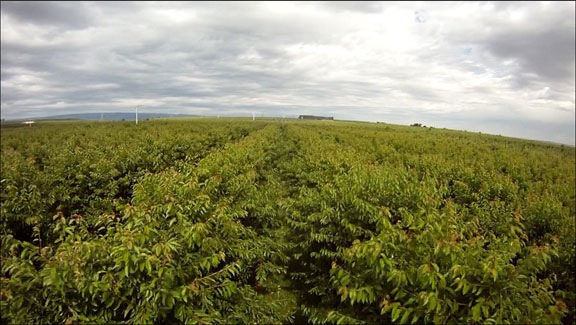
This is a typical view down an aisle of cherry trees. I fly very low.
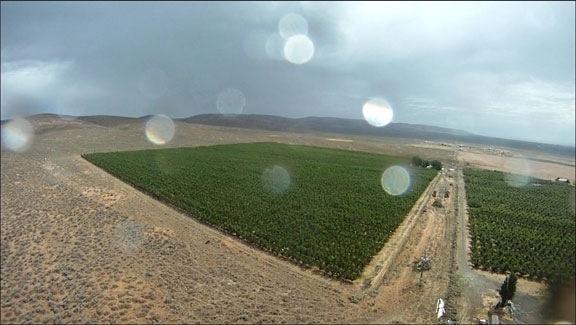
Here’s a shot as I approached the 40-acre orchard block. You’re looking at hundreds, if not thousands, of trees. It was still raining lightly as I flew up. I took the opportunity to land near the orchard and pull my door off. When the sun comes out, it gets very hot in the cockpit — especially when you’re wearing a Nomex flight suit and helmet.
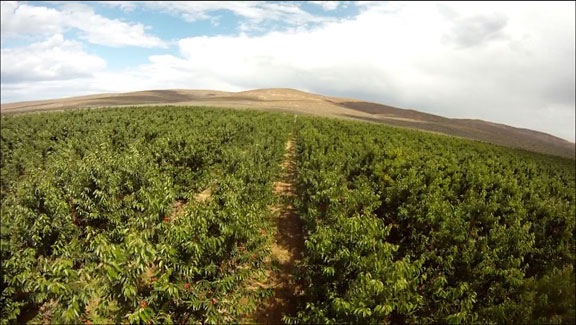
Here’s another drying shot. These trees are younger than the ones in the smaller orchard and were heavy with fruit, which you may be able to see in this shot. The sun was out for much of this dry, so time was of the essence.
Serious Business
Cherry drying is serious business. My client is paying me good money to sit around and wait for the rain. When the rain comes, it’s my job to quickly and effectively dry his trees. If I fail to do my job, my client can lose his entire crop. That could be hundreds of thousands of dollars worth of fruit, the difference between a profitable year and a year living on credit.
It’s a huge responsibility that I take very seriously.
The next time you eat fresh US-grown cherries, think about the folks in the production chain that put those cherries on your plate. I might be one of them.

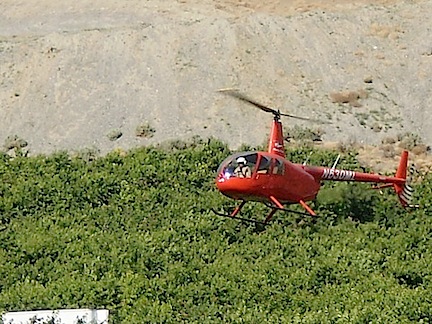 A few weeks ago, it came to my attention that this blog was the primary source of information about cherry drying by helicopter. Every day, pilots who wanted to learn more about cherry drying were stopping in to read up.
A few weeks ago, it came to my attention that this blog was the primary source of information about cherry drying by helicopter. Every day, pilots who wanted to learn more about cherry drying were stopping in to read up.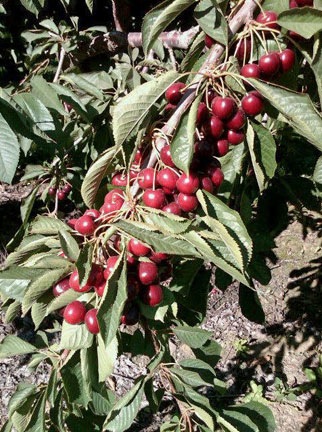




 Today is a beautiful day, with thin high clouds and puffy thick ones floating out to the northeast at about 10,000 feet. The forecast says mostly sunny. Again.
Today is a beautiful day, with thin high clouds and puffy thick ones floating out to the northeast at about 10,000 feet. The forecast says mostly sunny. Again.